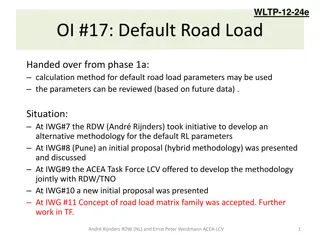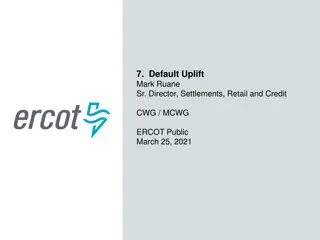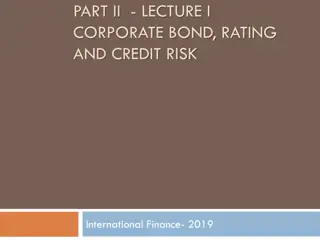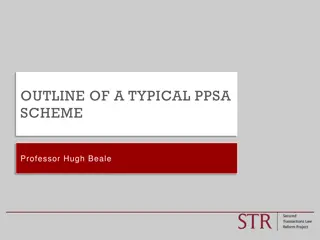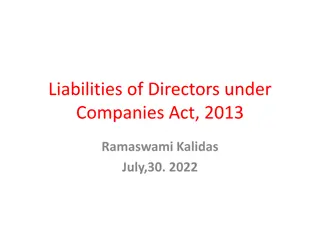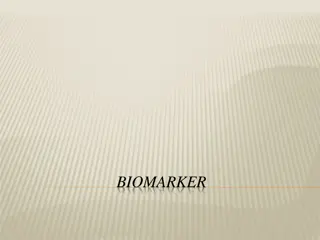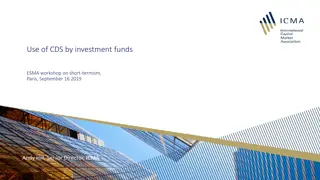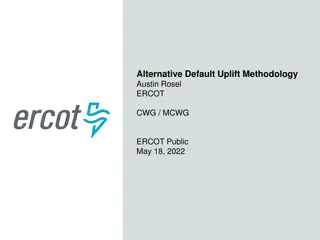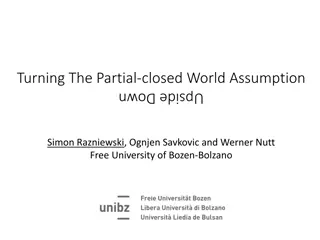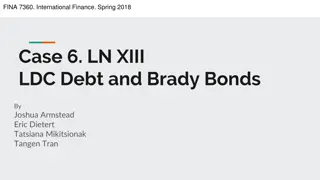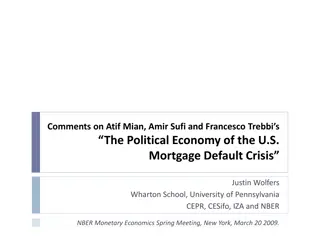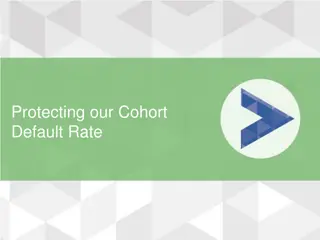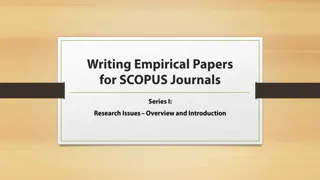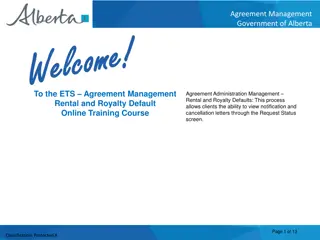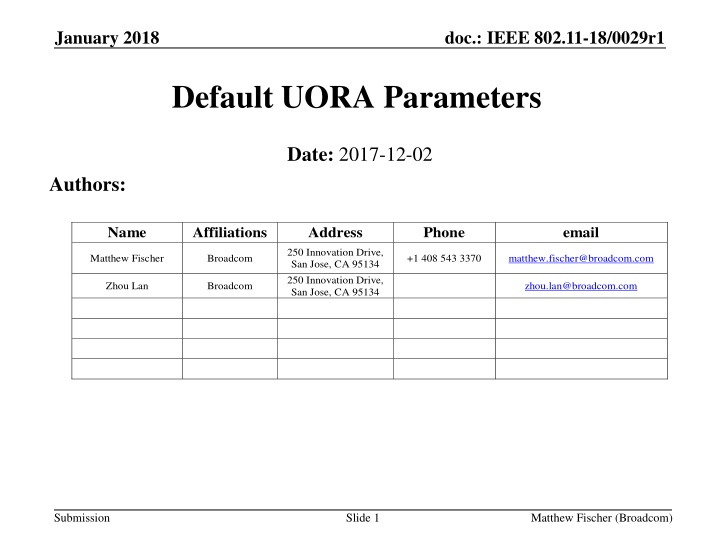
IEEE 802.11-18/0029r1 UORA Parameters for Minimizing Association Latency
Exploring the UORA parameters set in the January 2018 document for IEEE 802.11-18/0029r1, focusing on minimizing association latency by defining default values, trigger frequencies, and follow-up protocols for APs and non-AP STAs. The document addresses the need for clarifying participation rules, default values for unassociated STAs, and the timing of association exchange follow-up triggers, providing recommendations for dynamic scenario modifications to enhance efficiency.
Download Presentation

Please find below an Image/Link to download the presentation.
The content on the website is provided AS IS for your information and personal use only. It may not be sold, licensed, or shared on other websites without obtaining consent from the author. If you encounter any issues during the download, it is possible that the publisher has removed the file from their server.
You are allowed to download the files provided on this website for personal or commercial use, subject to the condition that they are used lawfully. All files are the property of their respective owners.
The content on the website is provided AS IS for your information and personal use only. It may not be sold, licensed, or shared on other websites without obtaining consent from the author.
E N D
Presentation Transcript
January 2018 doc.: IEEE 802.11-18/0029r1 Default UORA Parameters Date: 2017-12-02 Authors: Name Affiliations Address Phone email 250 Innovation Drive, San Jose, CA 95134 250 Innovation Drive, San Jose, CA 95134 Matthew Fischer Broadcom +1 408 543 3370 matthew.fischer@broadcom.com Zhou Lan Broadcom zhou.lan@broadcom.com Submission Slide 1 Matthew Fischer (Broadcom)
January 2018 doc.: IEEE 802.11-18/0029r1 Abstract UORA used for association procedure (AID12=2045) Need explicit expectations for AP and non-AP STA Goal for an expected typical case = minimize association latency Define default UORA parameters to be used by AP E.g. frequency of UORA, number of RA RU per trigger, initial OBO window Recommendations for modifying these parameters Should the need arise per dynamic scenario Define nature and timing of association exchange follow up triggers Define rules for participation in UORA by non-AP STA Submission Slide 2 Matthew Fischer (Broadcom)
January 2018 doc.: IEEE 802.11-18/0029r1 CID 11732 11732 Geonjung Ko For the faster channel access, an unassociated STA can participate in the UORA using the default values of OCWmin and OCWmax without receiving the UORA Parameter Set element. Need to clarify whether an unassociated STA can participate in the UORA even before receiving the HE or VHT Operation element. As in the comment Revise Tgax editor to implement the proposed text changes found in 11- 18/xxxxry that are marked with CID 11732 Submission Slide 3 Matthew Fischer (Broadcom)
January 2018 doc.: IEEE 802.11-18/0029r1 Need for UORA Defaults Association latency Minimize the latency How long must a STA wait for a UORA so that it can ASSOCREQ? When do the follow up Triggers occur for remaining ASSOC frames? DTIM has competition with MCAST So designate broadcast TWT for this purpose, or require associating STA to remain awake Multiple successes after a single UORA event - scheduling AP uses MU trigger to do the follow-up Need spacing of these BTWT, because AP and STAs need time between the RSNA AUTH messages to generate the next frame in the sequence Minimum spacing of X ms to accommodate a slow client Submission Slide 4 Matthew Fischer (Broadcom)
January 2018 doc.: IEEE 802.11-18/0029r1 UORA Parameters Which Need Defaults Frequency of UORA triggers E.g. every Xth Beacon OCWMIN initial backoff value OCWMAX value Number of RA slots specified by a single Trigger i.e. AID12 = 2045, i.e. unassociated STAs Submission Slide 5 Matthew Fischer (Broadcom)
January 2018 doc.: IEEE 802.11-18/0029r1 Rules of Behavior BTWT or other specified timing for Association sequence exchange Method to increase/decrease OCWMIN value Increase/decrease in RA slots AP could make an assumption that Non-UORA associations are proportional to UORA associations Might need to consider HE subset of non-UORA associations Submission Slide 6 Matthew Fischer (Broadcom)
January 2018 doc.: IEEE 802.11-18/0029r1 Eligible non-AP STA Which Non-AP STA can use UORA 2045 RA RU and for what purposes? E.g. based on existing parameters: Beacon and UORA Trigger RSSI values, MCS, RU allocation, Target RSSI AP can set these parameters to limit respondents Non-AP STA shall not respond if it does not expect its PPDU to be decodable based on the above parameters Only PREQ, Association, Authentication, pre-association Action frames allowed Resource request, BQR have other explicit paths RSNA, other post-association can be done with non-RA RU because association delivers an AID that allows a non-random allocation Submission Slide 7 Matthew Fischer (Broadcom)
January 2018 doc.: IEEE 802.11-18/0029r1 Proposed Values (1) UORA Trigger with 2045 RA RU(s) occurrence At least once per BI, can be accompanied by non-2045 AID RUs Association sequence Triggers AP to expedite subsequent Triggers for additional association exchange AP shall utilize DL MU responses when more than one non-AP STA has successfully transmitted an ASSOCREQ AP shall wait 8 ms between Triggers to allow slow STA time to compute next frame in exchange* Non-AP STA to remain awake for the subsequent Triggers during association exchange if it receives an acknowledgement to its ASSOCREQ * Delay could be a parameter in the association request Slide 8 Submission Matthew Fischer (Broadcom)
January 2018 doc.: IEEE 802.11-18/0029r1 Proposed Values (2) Number of RA slots is equal to: Min(4, N) Where N is equal to 1.5 x NU_ASSOC_AVE Where NU_ASSOC_AVE = the average number of Non-UORA based associations within each BI during the previous 10 BI Submission Slide 9 Matthew Fischer (Broadcom)
January 2018 doc.: IEEE 802.11-18/0029r1 Proposed Values (3) Default OCWMIN == 7 Default OCWMAX == 31 Modification to OCWMIN and OCWMAX AP can increase OCWMIN and OCWMAX using: OCWinc = (OCWcur + 1) x 2 1 AP can decrease OCWMIN and OCWMAX using: OCWdec = (OCWcur + 1) / 2 - 1 Submission Slide 10 Matthew Fischer (Broadcom)
January 2018 doc.: IEEE 802.11-18/0029r1 Proposed Values (4) AP modification of OCWMIN and OCWMAX Increase OCWMIN and OCWMAX When the number of successfully used RA slots for a single Trigger is greater than 50% of the total number of RA slots in that Trigger Using previously specified increase formula Also allow increase at AP discretion Decrease OCWMIN and OCWMAX When the number of successfully used RA slots for a single Trigger is less than 25% of the total number of RA slots in that Trigger Using previously specified decrease formula Submission Slide 11 Matthew Fischer (Broadcom)
January 2018 doc.: IEEE 802.11-18/0029r1 Proposed Values (5) UORA RA RU use rules Authentication, Association, Probe Request Response eligibility based on Trigger RSSI value, RU MCS, RU tone allocation, Target RSSI AP can set these parameters to limit respondents Non-AP STA shall not attempt to use an RU if it does not expect its PPDU to be decodable based on the above parameters Submission Slide 12 Matthew Fischer (Broadcom)
January 2018 doc.: IEEE 802.11-18/0029r1 Straw poll #1 Do you support the specification of a set of default UORA parameters and the rules for modifying and propagating those parameters and the rules for use of AID 2045 RA RUs as outlined in 11-18/xxxxry as the resolution for CID 11732? Y N A Submission Slide 13 Matthew Fischer (Broadcom)
January 2018 doc.: IEEE 802.11-18/0029r1 References [1] 802.11-2016.pdf [2] Draft P802.11ax_D2.0.pdf Submission Slide 14 Matthew Fischer (Broadcom)


